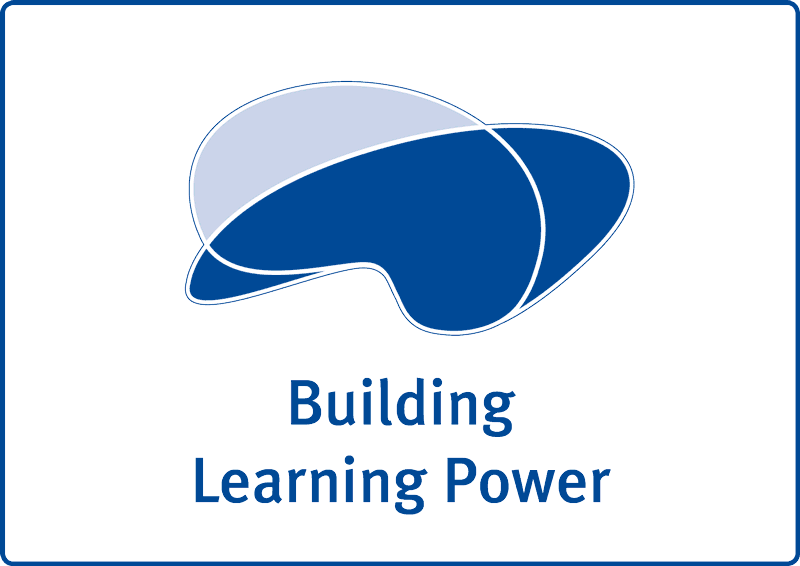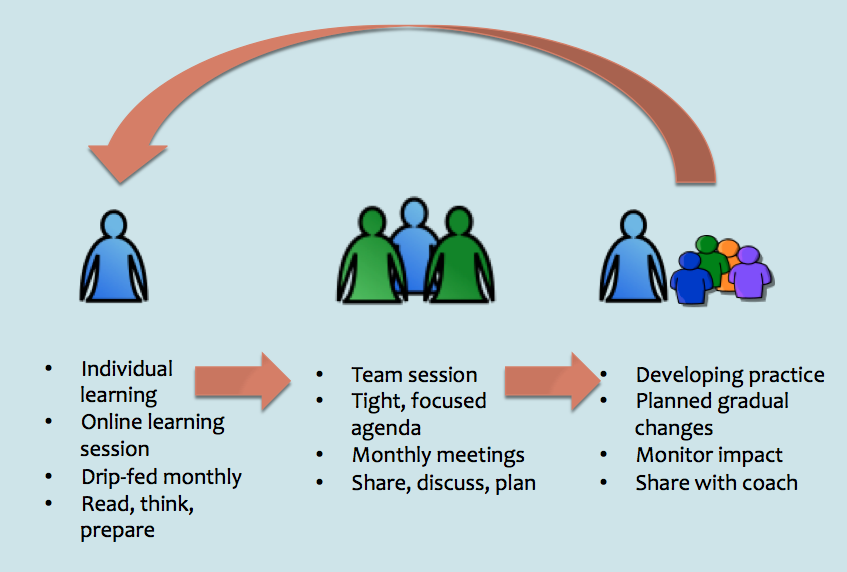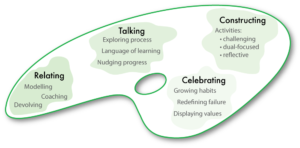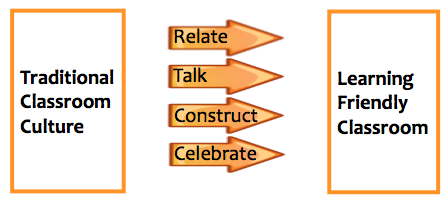The purpose of this resource is to assist senior leaders to discover which of the online programmes for secondary schools would best propel the school’s learning culture forward.
The following sections consider the practical details of:
Section 1 Building Learning Power: its purpose and key ideas. A quick reminder of what it’s all about.
Section 2 Learning cultures: where are we now? A broad consideration of learning cultures and a tool to estimate where the school is now. Plus a deeper exploration of what learning cultures are made of with a second tool to make sure your first estimate was correct.
Section 3 Bridging the gap in teaching. A closer look at the subtle changes in teaching for learning power with a tool to gauge current practice
Section 4 Blended learning programmes to ensure changes in practice. An explanation of the what, why and how of the blended learning programmes.
Section 1 Building Learning Power: its purpose and key ideas
Read this if you need a quick reminder about the basic models of Building Learning Power.
Read more...
Building Learning Power puts at the heart of education the development of psychological characteristics that are judged to be of the highest value in young people growing up in a turbulent and increasingly complex world. There are two main parts to the approach:
![BLP_Brain_Generic_no-Rs-[Converted]](https://www.buildinglearningpower.com/wp-content/uploads/2016/12/BLP_Brain_Generic_no-Rs-Converted-300x216.png)
A: a model of a learner and learning, in terms of a set of characteristics that work together to make a person a highly capable learner; we use ‘learning power’ to describe the effect. [The Supple Learning Mind]
B: a view of the kind of pedagogy that will nurture and strengthen the learning characteristics in ![]() young people. [The Teachers’ Palette]
young people. [The Teachers’ Palette]
These are bound together by the fundamental idea that ‘learning is a learnable craft’, and by explicit, detailed discussion of how learning works, supported by a rich repertoire of words and actions.
A. The Supple Learning Mind
The Supple Learning Mind framework, originally conceived and researched by Professor Guy Claxton, reveals learning as a complex process that isn’t just about thinking and having a good memory; it includes how we feel, how we think, how we learn with and from others and how we manage the process of learning. It gives the beginnings of a learning language that helps teachers think about how learning behaviours enable students to grow as learners and tackle the curriculum more profitably.
B. The Teachers’ Palette
The Teachers’ Palette provides an overview of aspects of a learning-friendly culture that combine to create the seedbed for building powerful learners. It includes the types of teacher actions that create the conditions necessary for such learning to become habituated – how teachers relate to students, the language they use, the types of tasks they design, and the things they celebrate and value; their teaching mindset.
The Supple Learning Mind framework of high value learning behaviours.
… captures each of the domains of learning:
- The Emotional domain of learning (feelings) in order to build Resilience.
- The Cognitive domain of learning (thinking) in order to build Resourcefulness.
- The Social domain of learning (relating) in order to build Reciprocity.
- The Strategic domain of learning (managing learning) in order to build Reflectiveness.
The Teachers’ Palette
Learning-friendly cultures systematically cultivate habits and attitudes that enable young people to face difficulty calmly, confidently and creatively. ‘Culture’ concerns the details of the micro-climate that teachers create in their classrooms. What they do and say, what they notice and commend and what they don’t, what kind of role model of a learner they offer ,how they design and present activities: all these are of the essence. For learners it’s a place where their role changes from receptivity to activity. For teachers it’s a place where their role changes from ‘delivering’ learning to students, to the creation of situations in which students learn.
This general philosophy is not new of course. There have long been many advocates for learning where students are more active and engaged. But because learning-centred teachers have a particularly rich conception of learning and the habits that underpin it, they are able to design nudges and activities that target quite specific aspects of learning behaviours. Teaching for learning becomes more detailed and forensic.
Section 2. Learning cultures. Where are we now ?
Text in this section also forms part of the online programme Nutshells 1, module A culture for building powerful learners. Use this section to estimate how learning friendly the school’s learning culture is now.
Find out about learning cultures
Section 2. Learning cultures. Where are we now ? Unpick the meaning of classroom cultures, what they might consist of and the big shifts that may be needed to develop better learning. Use the culture tool to estimate where your classroom cultures are now.
Building Learning Power is about creating a culture in classrooms – and in the school more widely – that systematically cultivates habits and attitudes that enable young people to face difficulty calmly, confidently and creatively. By a ‘culture’ we mean all the little habits, routines and practices that implicitly convey ‘what we believe and value round here’. Classrooms are the places where, hour by hour, students experience the values and practices that are embodied in the school, rather than just the ones that are espoused.
So what does a culture shift mean? What sort of classroom cultures are there and which one do we need if students are going to understand and improve themselves as learners?
Moving towards a culture that is ripe for students to learn about learning can take a while. Research undertaken by Chris Watkins, at the London Institute of Education, suggests three different types of classroom culture.
As you read on, think of these descriptions as stages in a journey you may need to travel.
Teacher centred classrooms
Firstly, many classrooms could be thought of as teacher centred. Here the overriding emphasis is on what the teacher is doing or saying. Learners have little to do but listen and be told what to do. In these classrooms students can see themselves as isolated, passive and dependent on the teacher for the acquisition of knowledge. The teacher and teaching are dominant. Students have what’s been called a ‘thin’ description of their own learning and they have an impoverished view of their own role in learning.
Highly teacher-centred classrooms don’t provide the fertile ground in which students are able to develop as better learners. Before students can begin to develop their learning behaviours it may be necessary to address some teaching behaviours first, so that teachers allow learning to become more active, less passive, more collaborative, less solitary, more learner-led, less teacher-directed.
Learner centred classrooms
The learner centred classroom is where students take a more active part in deciding what to do. The purpose is seen as the learner making meaning for themselves. So ‘content’ is not just stuff to be taught but for connecting to previous knowledge, extending understanding and helping learners to see things in new ways. Here there will be more collaborative learning where students have dialogues about what they are learning and create meaning together. There will also be more learner-driven learning where learners might have a role in the agenda through questioning or organising an enquiry and evaluating the products.
It is into classrooms like this that Building Learning Power can readily take root, helping the classroom to become a learning centred culture.
Learning centred classrooms
It’s only when the above dimensions are present to some extent that it becomes realistic to add another – that of learning about learning itself. Learners collaborating, taking a role in learning, using questions to drive learning and so forth give a firm platform on which to build powerful learners. Now we can add a language about learning for students and teachers alike, and practise meta-learning.(meta-cognition) Through such practices students come to see themselves as learners, develop stories about their experiences, understand the learning behaviours they are using and develop and propose improvements. They are able, consciously, to grow their learning habits.
Culture Tool 1
Read about three learning cultures
The image above offers some broad descriptors of the learning cultures just described. The gap between teacher and learning centred cultures is considerable. To move from a teacher focused to a learning focused culture requires learners to become increasingly more active and collaborative. If you try and add learning-centred (BLP) ideas to teacher focused regimes the change won’t stick and indeed could backfire and be detrimental. Where are your classroom cultures now?
Download a copy of this informal classroom culture review tool. ( Culture Tool 1 ) Spend a little time thinking about the classroom cultures across the school against the indicators. Where, broadly, would you say classroom cultures across the school are currently?
Highlight the indicators that best describe the classroom cultures now. NB. There will probably be a mixture of teacher and learner focused features.
Download Culture tool 1 [PDF]So where is the school’s classroom culture just now?
Consider your estimates across the 3 ‘panels’ of the Culture Tool.
- Which panel best describes the majority of classrooms in your school ?
- How wide is the in-school variation ?
- Estimate the proportion of classrooms that are predominantly teacher focused – it is this estimate that should indicate the school’s best approach to developing practice and accessing the most suitable online materials
Make a note of…
- Classrooms that you think are already learner focused.
From Culture Tool 1
If the prevailing classroom culture is predominantly teacher-centred, the Nutshells Phase 1 modules will help classrooms to become increasingly active, collaborative and learner-led, readying the way for building better learners.
- students who are passive recipients in panel 1 become more active participators in panel 2;
- students who learn predominantly on their own in panel 1 become increasingly collaborative in panel 2;
- and students who have little or no control of their learning in panel 1 begin to take some responsibility for their own learning in panel 2.
To begin to move the classroom culture towards panel 2, we suggest that you begin with Nutshells 1 programme which has three modules that assist teachers to shift to Panel 2. These are: Building active participation; Building collaborative approaches; Building learner responsibility. The order in which these are tackled is left to the school.
Culture Tool 2
Go a bit deeper into culture
Learning friendly cultures; Lots of little shifts. Find out about the four main dimensions of culture and use the Culture Tool 2 check whether your first estimate was right and then consider the sorts of shift your school’s classroom culture would benefit from.
What shifts?
Moving to more learning-friendly cultures takes lots of little shifts in thinking and action. To establish learning-friendliness it’s useful to think about four types of shift. A shift in relationships, a shift in the language, a shift in how learning is constructed and a shift in what is celebrated – what is seen to matter:
Why shift?
The more structured we make the environment the more structure the students need.
The more we decide for students the more they expect us to decide.
The more motivation we provide the less they find within themselves.
The more responsibility for learning we try to assume the less they accept on their own.
The more control we exert the more restive their response.
Weimar 2002.
Relating for learning: the changing roles and responsibilities of teachers and learners, where learning becomes a shared responsibility. Students are given more responsibility for their own learning, the role of the teacher changes from ‘the sage on the stage’ to ‘the guide by your side’; the role of the student moves from ‘passenger’ to ‘crew’ and ultimately ‘pilots of their own learning’.
Talking for learning: the sort of language content and style to enhance learning, making learning the object of conversation. The way we express ourselves in the classroom creates a powerful linguistic environment that teaches young people the best of what we know about learning. The language of learning helps students to discuss, understand, and become conscious of using their learning behaviours.
Constructing learning: activities and classroom routines feed learning habits and learning becomes the object of learning. Challenging learning activities are designed to enable students to understand both the content and the process of learning. They do this by having a dual focus – to explore content and stretch students’ use of their learning behaviours. There is a strong underpinning of not just ‘doing’ learning but reviewing and reflecting on the process in order to make meaning and apply it elsewhere (transfer).
The teacher’s role becomes one of surfacing learning; to make the learning process itself public; to train some of the tricky bits; to talk about it; to recognise and celebrate it as it happens; to nudge it along, assisting students to grow their learning capacities; and to design activity to stretch a wide range of learning habits. This uncovering of learning ensures students discover, use, understand and grow their learning habits. There is a shift in emphasis from performance to learning, from content to process, from teaching to coaching
- Download the deeper Learning Culture tool 2 and Learning Culture Review sheet.
- Look carefully at the Culture tool 2 in relation to classrooms and teachers across the school.
- Ring the statements which describe aspects of the culture that you think are, in general, secure.
- Underline in red those statements that would most benefit your students now.
- Record your analysis and musings on the Learning Culture Review sheet.
- Discuss your analysis with senior colleagues. Where are the agreements and disagreements?
From Culture tool 2
If the prevailing classroom culture really is already securely learner-friendly, the online modules in Nutshells Phase 2 will help to create a learning-centred classroom culture that builds self-aware, self-regulating learners. However, if you are not convinced that your culture is firmly in the middle panel we suggest you consider Nutshells Phase 1. You can find links to detailed descriptions of Nutshells Phases 1 and 2 at the end of this resource
Nutshells 2 is designed to help teachers to build learning powered learners, and given that your prevailing classroom culture is already learner-centred, you have a strong springboard from which to achieve this.
Section 3 Bridging the gap in teaching
Use this section to take a look at teaching itself.

Go in deeper still
The diagram above offers glimpses of the difference between traditional good teaching and teaching that enables learners to become better learners throughout their lives. Look through the following tabs to find out more about bridging this gap.
Making the shift from traditional good teaching to teaching for learning power.
Developing students as learning powered learners is a long term innovation. It requires more than reading a BLP book or At a Glance card, having a ‘stuck’ poster, displaying a picture of the Supple Learning Mind, using a visible thinking routine or two, adding ‘yet’ to ‘I can’t do it’. Even the traditional Inservice training day can only scratch the surface. This is because the approach has implications not just for student learning, but for staff learning too. Teachers’ habits as learners have to become part of the picture – how they go about changing is as relevant as what changes they want to bring about. This isn’t just about teachers knowing more about teaching, it’s about teachers teaching differently.
So, what does this ‘teaching differently’ look like?
Basically, teachers are going to become more forensic about learning, talking about the learning behaviours, stretching them through activities they offer, modelling them, and valuing them as they see learners using and developing them.
Either try this quiz yourselves or invite some teachers to complete it.
Look at the statements and work out:
- how often do you try to help students develop such behaviours by the way that you teach at present;
- how many of your students (roughly) display these behaviours in the classroom (without knowing it).
Having completed the quiz ask yourself:
From the left hand column:
- Which behaviours did you denote OFTEN?
- Which do you RARELY attend to?
- Which psychological domain seems to receive most attention? (emotional, cognitive, social, strategic)
- What might this reveal about your teaching?
- Key Question: How do you know if/how students are improving in these behaviours?
From the right hand column:
- Which behaviour was most difficult to assign students to? i.e. the things you may not know about your students
- What patterns are emerging?
- Is there a link between what you do and how students are as learners?
- What is this making you wonder?
How subtle is subtle? Where am I now?
This tool shows just some of the small, yet profound, shifts teachers make when they are surfacing learning.
Statements in the left-hand column are about conventional ‘good’ teaching. Those in the right-hand column show the subtle shift to developing students’ learning behaviours.
Estimate where you tend to function along the scale.
- Ponder on the statements and estimate which of the statements you are already working on
- Which others might you find it easy to try?
- Are these shifts the ones you want to make?
- Do they fit with your views of good teaching and learning?
- Are you willing to change your professional habits?
Making subtle shifts in practice takes a big effort in unlearning.
When teachers want different outcomes for their students it actually involves them in changing their teaching habits. It’s not simply about knowing about new techniques, it is about doing what they do differently. That’s much harder. It involves changes to:
- what they know – knowledge;
- what they believe – feelings or attitudes;
- what they can do – their skills;
- what they actually do – putting it all into practice.
So changing how one teaches is a delicate, complex process……...that’s why it’s hard!
And the hardest thing isn’t getting new ideas into teachers’ heads
It’s getting the old ones out…….that’s why it takes time and effort.
It takes time and practice to undo old habits and become graceful at new ones……that’s why we have based our learning programmes on research into how adults learn and the professional value of teacher learning communities. See the next section for more on this.
Section 4 Blended learning programmes to ensure changes in practice.

Read more
What it takes to grow innovative practice
For the school to take on wholeheartedly the new roles and new paradigms that minute-to-minute and day-by-day build better learning requires far more than just the quick exposure to its principles and methods you have seen thus far. Development of this magnitude asks a lot of teachers. They have to go through a process of un-knowing, re-learning, unpacking and re-adjusting.
The programme we have compiled is a careful blend of:
- online learning sessions….that faithfully disseminate the researched content for building better learners;
- professional learning team sessions ……actioned by the school that provide sustained, meaningful assistance; learning with and from colleagues;
- trying things out for yourself in the classroom……because “learning by doing” is integral to the development of expertise and expertise cannot be developed quickly. It can only be developed if teachers have ample opportunity for practice, reflection, and adjustment.
This trio of learning opportunities work together to help teachers replace long-standing habituated practices with more effective ones.
Why online learning ?
The online learning aspect provides the content of the Learning Power approach based on over 20 years of research and development in schools. It attempts to cut the big complex innovation of Building Learning Power into more bite size chunks that schools and teachers can make sense of and implement over time.
You might well wonder why such content merits online modules and why you can’t just read a book about it and get on with it. The online courses attempt:
- to offer bite size chunks for schools to implement;
- to faithfully offer the researched content in a do-able form i.e. so that you only get the bits we know work which saves you time twiddling about with stuff that may sound good but doesn’t do the job;
- to structure professional learning team sessions in schools because these are the best way of supporting and delivering changes in classroom practice.
The blended learning courses will enable the school to build better learners right not lite, make a complex set of ideas work on a practical level.
Why Learning Communities?
All the evidence shows that teachers change their practice when they work together and support each other in trying out new teaching strategies, within a culture of classroom based action research. It is about teachers being empowered to explore together to find out what works with their students, in this context, at this time. As a consequence, the school learns its way forward, together.
Teacher learning communities provide a forum for supporting teachers in converting the information and ideas from the online learning sessions into “lived” practices within their specific subjects and classrooms. Such communities provide a safe forum in which to:
- kick around ideas from the online content,
- unpack it’s meaning when it’s unclear,
- consider what’s do-able and appropriate for your students;
- make plans for what and how you might incorporate the ideas into your practice;
- share and unpack what you have tried in the classroom;
- relate your triumphs and tribulations;
- reflect on what you hope you might do differently.
That is why teacher learning communities work, and hence why learning through such communities lies at the heart of these learning programmes. Teacher learning communities are the engines of teacher development.
We would be happy to welcome your school to the growing family of schools that are taking part in the online blended learning programmes.
Here are some reminders about what you have discovered about your school and how this relates to programmes for secondary schools.
Read more about:
Learning Habits in a Nutshell – Phase 1 Learning Habits in a Nutshell – Phase 2




Comments are closed.